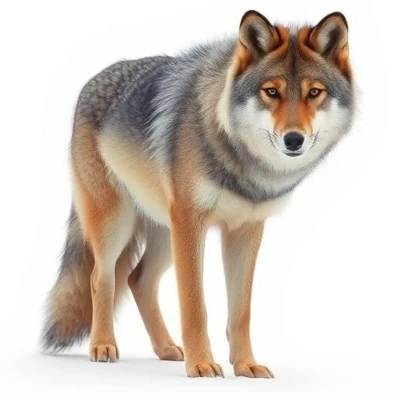
The Eastern Canadian Wolf (Canis lycaon), also known as the Eastern Gray Wolf, is an iconic canid of the vast boreal forests of eastern Canada. Smaller than its cousin the gray wolf, but just as fascinating, this predator plays a crucial role in the balance of forest ecosystems.
The Eastern Canadian Wolf is a medium-sized canid, measuring between 60 and 80 cm at the withers and weighing between 25 and 40 kg. Its coat ranges from gray to reddish-brown, often with lighter markings on the face and legs. Its thick fur allows it to withstand the harsh Canadian winters.
The Eastern Canadian Wolf (Canis lycaon) belongs to the Canidae family. Here is its scientific classification:
This species is genetically distinct from the gray wolf (Canis lupus) and exhibits unique characteristics adapted to its forest environment.
The Eastern Canadian Wolf primarily inhabits the mixed and boreal forests of eastern Canada, particularly in Ontario, Quebec, and the Maritime provinces. Its territory often extends over vast forested areas where prey is abundant. These wolves generally avoid heavily urbanized areas.
Contrary to popular belief, the Eastern Canadian Wolf is a social animal that lives in family packs. These groups, typically consisting of 4 to 6 individuals, hunt and raise their young together. Communication within the pack is done through howling, body postures, and facial expressions.
The Eastern Canadian Wolf is a carnivore whose diet mainly consists of white-tailed deer, moose, and small mammals such as beavers and hares. During times of scarcity, it may also feed on berries and other plant materials. A pack can travel up to 30 km a day in search of food.
The status of the Eastern Canadian Wolf varies by region. Although it is not considered threatened at the national level, some local populations are in decline due to habitat fragmentation, poaching, and road collisions. Conservation programs are in place to protect this important predator.
The Eastern Canadian Wolf (Canis lycaon) shares close genetic ties with several other North American canids:
Observing Eastern Canadian Wolves in their natural habitat is a rare and memorable experience. Here are some tips for responsible observation:
By following these tips, you will maximize your chances of observing these magnificent predators while minimizing your impact on their environment.